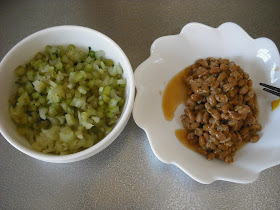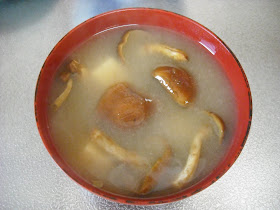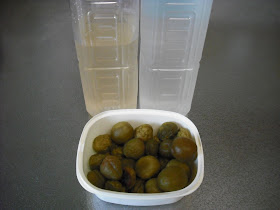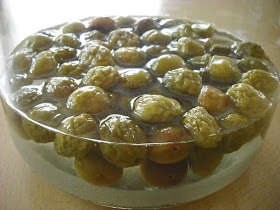Note:
In Japan, this drink is called ume juice or ume syrup. In Japanese, the word juice is used to mean
any non-alcoholic drink. To mean fruit
extract, the more accurate word kajuu is used.
Ingredients:
1 kg ao ume, literally blue ume but
actually green ume, i.e., unripe ume
800 g to 1 kg sugar
(I used 1 kg shiro zatou, the most common
type of sugar in Japan. Some recipes
recommend using rock sugar.)
Equipment:
Glass jar with a capacity of 3 liters or greater
You will need alcohol to sterilize the jar.
注: 日本では、この飲み物は梅ジュースとか梅シロップと呼ばれています。日本語では、アルコールの入っていない飲み物なら何でも「ジュース」と呼ばれます。果物から採った汁を指すには、もっと正確な「果汁」という言葉を使います。
材料:
青梅 1 kg。青梅とは、実際は緑色の梅、つまり、未熟の梅のことです。
砂糖 800 g~1 kg
(私は、日本では最も一般的な白砂糖を1 kg使いました。氷砂糖を薦めるレシピーもあります。)
器具:
容量3リットル以上のガラス瓶
ガラス瓶を殺菌するのにアルコールが必要です。
Directions:
1. Wash
ume and soak in cold water for a few hours.
(I soaked mine for 1 hour. Some recipes do not say to soak ume.)
2. Remove
"heta" (calyx) from each ume, with a toothpick or something similar.
3. Dry
each ume, using dry cloth.
4. Put
all ume in a plastic bag, and put in the freezer overnight.
(Some recipes recommend not freezing ume.)
5. Wash
jar, and sterilize the inside with alcohol.
6. Put
some sugar in jar first, then some ume. Repeat
this step, making sure that you top it with sugar.
Correction: Put some ume in jar first, then some sugar.
7. Leave
jar in a cool, dark place, with some newspaper beneath it.
8. Shake
jar once or twice a day.
Ume drink will be made in one week to ten
days.
To drink, dilute with four to five times
the amount of water.
Some recipes recommend sterilizing ume
drink at 80C for 10 to 15 minutes before storage.
作り方:
1. 梅を洗い、水に数時間漬けます。
(私は1時間漬けました。梅を漬けないレシピもあります。)
2. 楊枝などで、梅から「へた」を取ります。
3. 乾いた布で、梅を拭きます。
4. 梅を全部、ビニール袋に入れ、冷凍庫に一晩置きます。
(梅を凍らせないほうがいいと言うレシピもあります。)
5. 瓶を洗い、内側をアルコールで消毒します。
6. 最初に、瓶に砂糖を少し入れ、次に梅を少し入れます。これを繰り返します。最後には上部に砂糖が来るようにします。
訂正:最初に、瓶に梅を少し入れ、次に砂糖を少し入れます。
7. 下に新聞紙を敷いて、瓶を冷暗所に置きます。
8. 瓶を毎日1~2回、振ります。
梅ジュースは1週間~10日でできます。
飲むには、4~5倍の水で薄めます。
80Cで10~15分間、殺菌してから保存することを薦めるレシピもあります。
This is the "heta" of an ume.
これが梅の「へた」です。
It's rather time-consuming to remove the
heta from each and every ume.
梅一つ一つのへたを取るのはちょっと時間がかかります。
Obviously, my jar was way too big for 1 kg
ume.
見て分かるように、この瓶は1 kgの梅には大き過ぎました。
Ten days have passed.
十日(とうか)が過ぎました。
Almost all ume are now wrinkled up.
梅は殆ど、しわくちゃだらけです。
I had one glass.
一杯飲みました。
I was a little disappointed by the flavor. I had thought it would be more sour.
味には少しがっかりしました。もう少し酸っぱいだろうと思っていたので。
Some recipes recommend using the used ume
to make ume jam. I tasted the ume, and
decided not to. Not much flavor left.
使った梅を使って梅ジャムを作ることを薦めるレシピもありますが、食べてみて、諦めました。あまり風味が残っていないので。



















































